Dear members of myArmoury,
first, thank you for all the valuable information I found lurking here for months.
In the end I decided to register and open this thread regarding a sword I had the fortune to examine with my own hands thanks to a reasonable curator of a small museum in Northern Italy.
[ Linked Image ]
As you can see it's a broken sword that was found in the 60s while they were making a new road. If it was broken when the TLB hit the burial or at the time of the death of the owner they don't know, for sure the body was destroyed in the process and what was left behind is this rump and a complete scramasax
It was quickly identified as Langobardic because of the other blade (for some strange reasons they thought the scramasax was a weapons used just by that tribe) but personally speaking all the Langobard swords I've seen in Italian museums (those found int he necropolis of Trezzo d'Adda and Nocera Umbra) were ring-hilted like many Scandinavian and Saxon swords of that era. This is the particular of the hilt:
[ Linked Image ]
[ Linked Image ]
As you can see it seems that the hilt was hammered directly from an extension of the tang (it was not removable like in many ME swords of the with and VIIth century) so I would say it's a pretty advanced feature that I would expect from a much later Viking era sword...that intrigues me a lot and I would like to know the opinion of the knowledgeable people here.
I and the archeologist in charge of the museum draw a scheme of the sword and we took all the measurements (well, most of them at least), the rump is about 400 mm long, the blade is initially 50 mm large and tapers to 45 mm at the fracture, so it feels long and slender. The tang is 125 mm long, the hilt is 56 mm wide and 22 mm wide...the decorations feels to me very Nordic, they're different from one side to the other, and looks like they were carved directly in the steel and then covered with a thick layer of silver hammered on the base metal.
Being the sword broken, we estimated a length between 770 to 810 mm due to the low taper, relative thickness and the comparison with complete swords I know.
According to the Behmer's chart that I shamefully downloaded from this side it looks like...a Type VIII sword?
Many thanks in advance to those who will shed some light on this interesting finding.
I'm not an expert by any means and could be completely wrong but that looks like a straight up type X to me.
Really interesting pommel too, they really put in a lot of customization on pommels it seems. And that almost looks like a hand and a half length grip, that's really long for 1 hand.
Really interesting pommel too, they really put in a lot of customization on pommels it seems. And that almost looks like a hand and a half length grip, that's really long for 1 hand.
| Alex Cerioli wrote: |
| Dear members of myArmoury,
first, thank you for all the valuable information I found lurking here for months. In the end I decided to register and open this thread regarding a sword I had the fortune to examine with my own hands thanks to a reasonable curator of a small museum in Northern Italy. [ Linked Image ] As you can see it's a broken sword that was found in the 60s while they were making a new road. If it was broken when the TLB hit the burial or at the time of the death of the owner they don't know, for sure the body was destroyed in the process and what was left behind is this rump and a complete scramasax It was quickly identified as Langobardic because of the other blade (for some strange reasons they thought the scramasax was a weapons used just by that tribe) but personally speaking all the Langobard swords I've seen in Italian museums (those found int he necropolis of Trezzo d'Adda and Nocera Umbra) were ring-hilted like many Scandinavian and Saxon swords of that era. This is the particular of the hilt: [ Linked Image ] [ Linked Image ] As you can see it seems that the hilt was hammered directly from an extension of the tang (it was not removable like in many ME swords of the with and VIIth century) so I would say it's a pretty advanced feature that I would expect from a much later Viking era sword...that intrigues me a lot and I would like to know the opinion of the knowledgeable people here. I and the archeologist in charge of the museum draw a scheme of the sword and we took all the measurements (well, most of them at least), the rump is about 400 mm long, the blade is initially 50 mm large and tapers to 45 mm at the fracture, so it feels long and slender. The tang is 125 mm long, the hilt is 56 mm wide and 22 mm wide...the decorations feels to me very Nordic, they're different from one side to the other, and looks like they were carved directly in the steel and then covered with a thick layer of silver hammered on the base metal. Being the sword broken, we estimated a length between 770 to 810 mm due to the low taper, relative thickness and the comparison with complete swords I know. According to the Behmer's chart that I shamefully downloaded from this side it looks like...a Type VIII sword? Many thanks in advance to those who will shed some light on this interesting finding. |
That's a really lovely find - is there any chance that you have some close-up pictures of the blade itself? I'd love to be able to check out the pattern-welding...
| Christopher B Lellis wrote: |
| I'm not an expert by any means and could be completely wrong but that looks like a straight up type X to me.
Really interesting pommel too, they really put in a lot of customization on pommels it seems. And that almost looks like a hand and a half length grip, that's really long for 1 hand. |
Type X like these?
http://www.myArmoury.com/feature_spotx.html
I might be mistaken, but this one doesn't look anything like that. :\
And yes, I also thought it was one hand and half, and it would be if there was no organic parts of the hilt, probably it's because both sword and tang are very slender; the latter tapers from 20 mm to 12 and the pommel is very small (and detailed).
| Robert B. Marks wrote: |
|
That's a really lovely find - is there any chance that you have some close-up pictures of the blade itself? I'd love to be able to check out the pattern-welding... |
Call me an idiot but this Friday I went to the museum without camera and I couldn't take any additional pics! I just have what the curator gave me, she wasn't aware of the existence of pattern welded steel (she's specialized in bronze age) so I sent her some material I found here and some on the Sutton Hoo...she became immediately curious.
I invited a swordsmith who lives not too far away from here and he's the only one that I know who makes pattern welded steel (and he's also quite skilled, as you can see : http://www.forgiapizzi.it/wp-content/uploads/...hinga.jpg) but he dropped at the last minute.
This was the first time I handled such an old blade and it was quite an experience. From the scarce documentation she was in possess they wrote the sword was "restored" but what they did to the sword isn't clear: we think they sprayed something over the metal because it look black and glossy, and at that time archeologist at least in this country were butchers, so couldn't see what pattern welded structure was present, even if I'm 95% the blade is pattern welded because the edges in certain points look almost new and feel almost sharp while all the corrosion and bubbles are in the certer of the blade. IMO from my scarce direct esperience I would say the steel of the edges is more martensitic and more corrosion resistant than the core, perhaps in this pic what I mean is more clear:
[ Linked Image ]
In particular the detail here:

Last edited by Alex Cerioli on Mon 26 Aug, 2013 8:36 am; edited 2 times in total
Calling all swordsmiths...Calling all swordsmiths ! We need a replica here! :D .......McM
| Mark Moore wrote: |
| Calling all swordsmiths...Calling all swordsmiths ! We need a replica here! :D .......McM |
So my real intentions have been quickly discovered! :D
I made a 1:1 drawing of the sword and the scramasax, that was also VERY interesting: perfect triangular section, 8 thick at the top...who would be the best man for the job? Berta?
This is the first part of the drawing I made tracing the profile of the original sword:
[ Linked Image ]
Of course scaled down...in the end we tried to "guess" the length of the sword and we made two reconstruction plans, one for a 770 mm sword and the other for a 8\0 mm....the latter is epic and required 3 A3 sheets.
This is the saex:
[ Linked Image ]
Unfortunately my skills with paint are limited and merging to sheets was difficult, but the profile is correct.
EDIT: Removed for inaccuracy.
Last edited by Ian Hutchison on Mon 26 Aug, 2013 12:21 pm; edited 1 time in total
Ehm, perhaps it wasn't clear, the total "free length" between the end of the blade and the silver inlayed hilt is 125mm, and guessing a 12 mm thickness for the compound upper and lower guards the "usable length" of the organic grip should have been 101 mm, that would be about 4", that would be just right for a large hand with thick gloves, unless of course we presume that in the rare cases these swords weren't use with a shield the warrior could place the weak hand on the hilt itself.
That is of course if I did the math correctly on the crossguards: on the drawings I imagined a reconstruction with two "slices" of silver or brass about 2 mm thick and a wooden or horn spacer about 8 mm...are these numbers realistic? Or in the case it's a type VIII sword, should I consider a pancake of three layers 4 mm each? :confused:
That is of course if I did the math correctly on the crossguards: on the drawings I imagined a reconstruction with two "slices" of silver or brass about 2 mm thick and a wooden or horn spacer about 8 mm...are these numbers realistic? Or in the case it's a type VIII sword, should I consider a pancake of three layers 4 mm each? :confused:
| Alex Cerioli wrote: |
| Ehm, perhaps it wasn't clear, the total "free length" between the end of the blade and the silver inlayed hilt is 125mm, and guessing a 12 mm thickness for the compound upper and lower guards the "usable length" of the organic grip should have been 101 mm, that would be about 4", that would be just right for a large hand with thick gloves, unless of course we presume that in the rare cases these swords weren't use with a shield the warrior could place the weak hand on the hilt itself.
That is of course if I did the math correctly on the crossguards: on the drawings I imagined a reconstruction with two "slices" of silver or brass about 2 mm thick and a wooden or horn spacer about 8 mm...are these numbers realistic? Or in the case it's a type VIII sword, should I consider a pancake of three layers 4 mm each? :confused: |
Ah, sorry, I was judging by the perspective your photographs. Yes, 10cm much more normal.
Nice pommel! So, is the pommel somehow attached to the tang or peened on the top? I see no rivet holes...
Not peened as far as I could see. It looks like one piece with the tang....if it's possible to do it,
I wonder how they made it, do usual ME sword have peened hilts?
I wonder how they made it, do usual ME sword have peened hilts?
The usual way would be to peen the tang over the upper guard of sandwiched materials and pommel riveted to the upper guard with 2 rivets. If this is one piece with the tang, I don't know how upper guard was put on?
I have seen many examples of lombard swords from Brescia and Leno (Northern italy), in all cases there were no remains of any guard, and a small triangular pommel.
I do not think this sword was any different from them, in that it most likely had an entirely organic hilt and guard. If it were otherwise some remains of a cross would have resisted on at least a few specimens.
This one just shows a more elaborate pommel, with inserts of typical lombard fashion.
I do not think this sword was any different from them, in that it most likely had an entirely organic hilt and guard. If it were otherwise some remains of a cross would have resisted on at least a few specimens.
This one just shows a more elaborate pommel, with inserts of typical lombard fashion.
| Luka Borscak wrote: |
| The usual way would be to peen the tang over the upper guard of sandwiched materials and pommel riveted to the upper guard with 2 rivets. If this is one piece with the tang, I don't know how upper guard was put on? |
Yes I also thought a functional assembly should work this way, but usually as far as we see in many cases the pommel can be found separated from the upper metal layer of the hilt...could it be that in this case the pommel was heated and then fitted to the hilt? If there was an additional penning on the upper guard we should see a notch on the tang or anything like that.
Where are our experts of Migration swords? We need answers! :D
| Bruno Giordan wrote: |
| I have seen many examples of lombard swords from Brescia and Leno (Northern italy), in all cases there were no remains of any guard, and a small triangular pommel.
I do not think this sword was any different from them, in that it most likely had an entirely organic hilt and guard. If it were otherwise some remains of a cross would have resisted on at least a few specimens. This one just shows a more elaborate pommel, with inserts of typical lombard fashion. |
If you have more info about these swords feel free to post them, today I was sick and in the morning I visited the famous museum of Castelvecchio in Verona, I would suggest anybody on this board to go there because they have a lot of stuff, especially from the XIIth to the XVIth century, full plate armours, zweihaenderen and stuff like that.
Unfortunately they don't have much space so most of the Langobardic stuff is packed, but they have five swords, of which four complete, in on corridor. And the broker does have a COMPLETE hilt: it's the famous Ciringhelli sword, that looks to me like a Behmer type VIII, not supposed to exist in Italy.
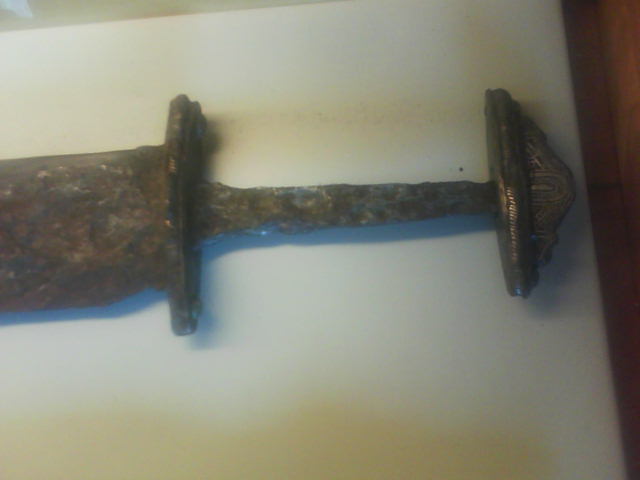
| Robert B. Marks wrote: |
|
That's a really lovely find - is there any change that you have some close-up pictures of the blade itself? I'd love to be able to check out the pattern-welding... |
Seeing that you're a pattern-welding fetishist like me I think you're gonna like these pics (sorry if they're so bad, I've a phone of the 90s and they didn't allow me to open the glasses), these blades have the crispest pattern-welding traces I've ever seen, you don't need X rays to see where the bar is twisted and where it's linear.
By the way, some of them are on the heavy and long side: one is 82,5 cm long (approximately, I wasn't allowed to measure all I wanted to measure), another one is 80 cm and it's very wide, just one is short (72 cm) and another average length (78 cm).
I promise I'll try to take all the measurements for the nice people of the board once I completed the formal request.
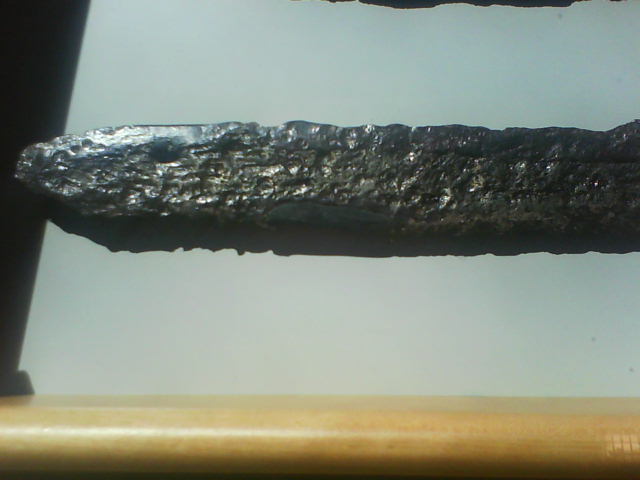
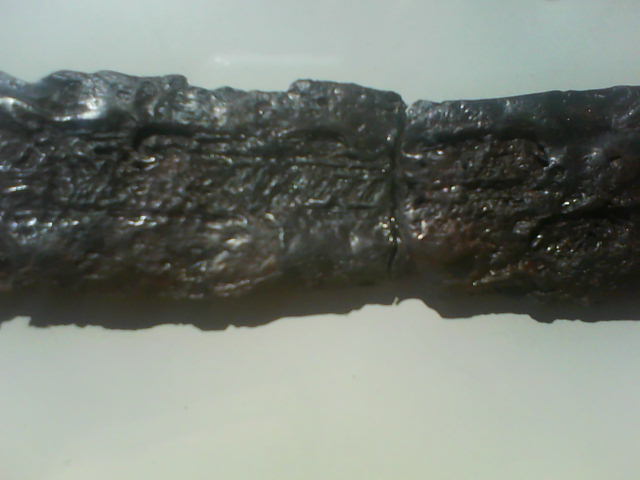
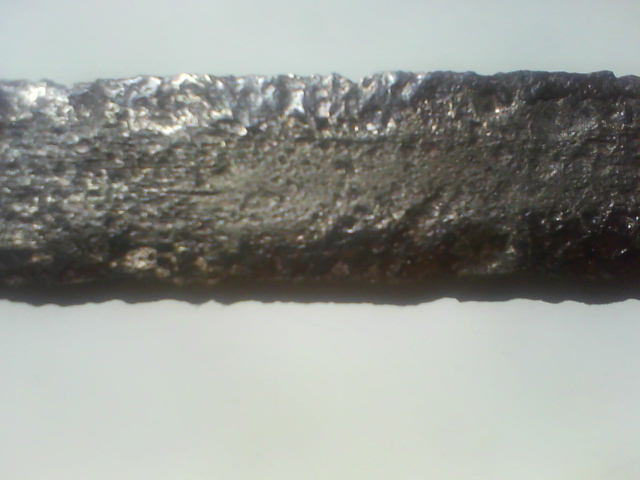
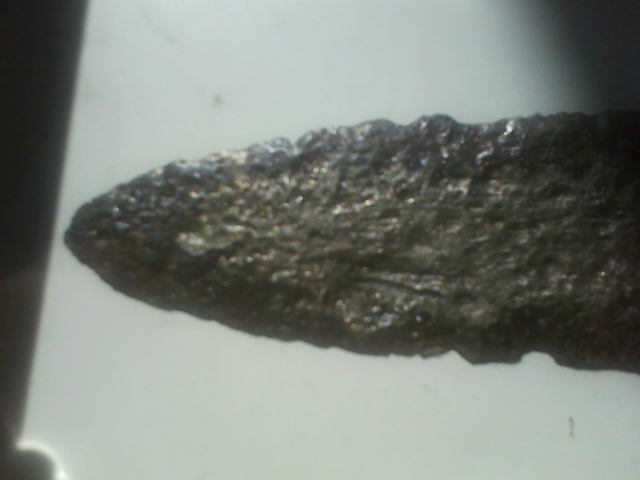
Some of the brescian blades are pattern welded as well. They have interesting patterns, but I have likely lost all my pics.
The pommel of the blade of this topic is engraved in a way that is very similar to that of the engravings present on some of the Montichiari museum finds (again brescian area).
The pommel of the blade of this topic is engraved in a way that is very similar to that of the engravings present on some of the Montichiari museum finds (again brescian area).
| Bruno Giordan wrote: |
| Some of the brescian blades are pattern welded as well. They have interesting patterns, but I have likely lost all my pics.
The pommel of the blade of this topic is engraved in a way that is very similar to that of the engravings present on some of the Montichiari museum finds (again brescian area). |
I'm not familiar with that museum, do you have pics of the swords you you are talking about? I opened this thread to discuss about Longobard swords because there is little material on Italian swords, unlike on Wiking, Carolingian and Anglo-Saxon blades, if you can contribute on the matter I think a lot of people will be interested.
| Alex Cerioli wrote: | ||
Seeing that you're a pattern-welding fetishist like me I think you're gonna like these pics (sorry if they're so bad, I've a phone of the 90s and they didn't allow me to open the glasses), these blades have the crispest pattern-welding traces I've ever seen, you don't need X rays to see where the bar is twisted and where it's linear. By the way, some of them are on the heavy and long side: one is 82,5 cm long (approximately, I wasn't allowed to measure all I wanted to measure), another one is 80 cm and it's very wide, just one is short (72 cm) and another average length (78 cm). I promise I'll try to take all the measurements for the nice people of the board once I completed the formal request. |
Now that's just beautiful...absolutely beautiful...
And just imagine what it looked like 1400 years ago or so, when it was first presented to its owner...
| Robert B. Marks wrote: |
|
Now that's just beautiful...absolutely beautiful... And just imagine what it looked like 1400 years ago or so, when it was first presented to its owner... |
I wonder how many people it killed...I know, a little morbid, but I couldn't avoid thinking about it.
I also wonder what the British Museum or the Historiska at Stockholm would do with this material, the museum of the castle just left this stuff, the seaxes, the rings, the belts etc... in two small showcases in a tiny corridor between the two main rooms of the armoury, I assume they don't think they're too important....and according to the security they still have something like ten swords int he warehouse because they don't have enough room to show all the material they excavated through the years.
However that's another interesting blade of the same period, it looks like it's covered with wood...I assume it's what remains of the scabbard, my understanding is that it was filled with oil to avoid the formation of rust and probably in certain archaeologic conditions it adhered to the steel...and it's huge, I couldn't measure it because I was allowed to, but from the catalogue it seems that just the blade is 80 cm long and 6.5 cm thick, plus 10 cm of tang, my understanding is that it's as big as a large Viking sword they made several centuries later.
If anybody needs more pics just let me know
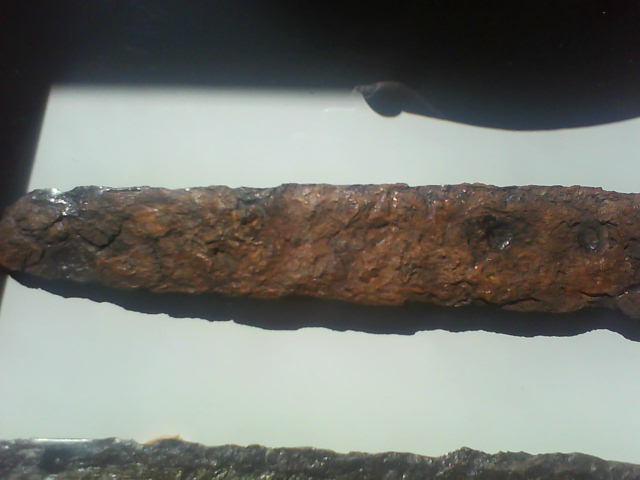

Page 1 of 1
You cannot post new topics in this forumYou cannot reply to topics in this forum
You cannot edit your posts in this forum
You cannot delete your posts in this forum
You cannot vote in polls in this forum
You cannot attach files in this forum
You can download files in this forum
All contents © Copyright 2003-2006 myArmoury.com — All rights reserved
Discussion forums powered by phpBB © The phpBB Group
Switch to the Full-featured Version of the forum
Discussion forums powered by phpBB © The phpBB Group
Switch to the Full-featured Version of the forum